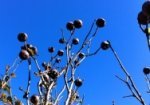Apple snow! I have such fond memories of having apple snow as a child – you never hear of it any more! (Ruth, a visitor at Vaucluse House)
As the summer progresses with its many heatwaves we find ourselves turning to the freezer for instant reprieve – cooling off with an ever-more-stylish selection of ice-creams, sorbets and gelatos that are now on the market. But the hot weather has also inspired me to explore some of the lighter and more cooling desserts from our past, before the advent of the domestic freezer. I’m delighted to have discovered summer snow.
Snow and snow eggs
‘Snows’ and snow eggs date back to at least Elizabethan times. Whipped egg-white, often infused with sugar, was used to ornament various dessert dishes – literally mimicking snowy landscapes with the purest white ‘froth’ spooned over rosemary sprigs or forming white mountains. A light snow was quite an achievement when we think that at best the whites could be whipped with a fork, or an innovative cook might use two forks sandwiched together, tines inter-twined. Some early recipes suggest the eggs be whipped by hand – as in using your fingers as a whisk, for up to an hour!
Essentially now meringue, the whipped mixture could be poached (in the style now known as Italian meringue) or ‘dried’ in a low oven in the same way we now make pavlova. Another way was not to cook it at all, but to bind the stiffened egg white with fruit puree and serve it as a sweetened froth. A hint of rose or orange blossom water would add delicate flavour and fragrance. For a time its whiteness, representing purity, was part of the snow’s affect, but over time trends changed and colouring the dessert gave a prettier finish.
Local snow
Most popular in early Australian cookbooks appear to have been sago snow and apple snow, both which are deliciously light and cooling. I’ve been researching the family cookbooks in the Rouse Hill collection (which will be featured in more detail in the coming weeks) and in a chance conversation with a Rouse family descendent about her childhood food memories, apple snow was singled out with great delight. The Rouse’s enjoyed apples from their own orchards, and eggs from their poultry, so there would usually be a good supply of eggs for custards, and snows!
The recipe below comes from an early 1910s edition of the Commonsense Cookery Book in the Rouse family cookbooks collection, in its Summer Puddings section. I checked my 1980s edition, and there it was, exactly the same! It recommends you use the egg yolks to make a custard to serve with it.
A familiar friend
As I read the recipe through, it sounded very familiar. Apple Snow recipe is almost exactly the same as one for a Floating Island in another of the Rouse family’s books – Maria Rundell’s Domestic Cookery (first published in 1806 but still in print in the 1870s). It calls for pureed ‘codlins’ an old apple variety, orange flower water, and was coloured with beetroot or raspberry juice and served over a white syllabub-style cream or custard.
Apple snow
Ingredients
- 2 apples, peeled, cored and sliced
- 1 whole clove
- 1 2-cm piece lemon peel
- 2 tablespoons lemon juice, strained
- pink or green food colouring
- 1 tablespoon caster sugar, or to taste
- a drop of rose water (or orange-blossom water) (optional)
- 1 egg white
- 1 tablespoon caster sugar, extra
Note
Named snows for their delicate lightness, these puddings have been popular since the 17th century. This recipe is based on an early Commonsense cookery book (c1917). The rose- or orange-blossom water adds a distinctly Regency touch.
As with any meringue or recipe requiring whipped egg white, your equipment must be squeaky clean, without a trace of oil or grease, or the egg white will never reach a stiff peak.
Serves 4
Directions
| Put the apple, clove, lemon peel and juice into a saucepan. Mix enough food colouring in 30 ml of water to create a delicate hue and add to the pan over a gentle heat. Bring to a simmer, reduce the heat to low, cover with a lid and poach the apples for 10–15 minutes or until the fruit is very soft. Check and stir occasionally, adding just a little more water if the fruit starts to stick to the bottom of the pan. Once the apple is soft, remove the pan from the heat and drain away any excess liquid. Remove and discard the clove and lemon peel. Sprinkle the sugar over the fruit while it is hot, stirring until the sugar dissolves. Mash the fruit or puree it with an electric stick blender. Add the rose- or orange-blossom water, if using. Put the fruit puree into a large bowl and allow it to cool. | |
| Whisk the egg white until thick and glossy. Continue to whip, adding the extra sugar gradually until stiff peaks form. | |
| Gently fold the whipped egg white through the puree with a large metal spoon until incorporated, but don't beat or over mix. Refrigerate the mixture for at least 1 hour. | |
| Serve the snow in a pretty dish or dainty stemmed glasses for individual servings. | |
| Cook's note: Other fruit such as peaches or berries may be substituted for some or all of the apple, eliminating the need for added food colouring, or you could choose a complementary colour and adjust the amount of sugar added. | |
Survival of the fittest?
The Commonsense Cookery book celebrates its 100th anniversary this year – no doubt its still in the centenary 2014 edition? But alas, it hasn’t survived the latest revision.


 Print recipe
Print recipe

